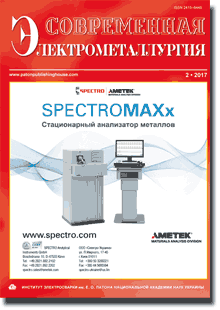| 2017 №02 (01) |
DOI of Article 10.15407/sem2017.02.02 |
2017 №02 (03) |

Electrometallurgy Today (Sovremennaya Elektrometallurgiya), 2017, #2, 11-16 pages
Structure and properties of new high-strength titanium alloy T120, produced by the method of EBM after deformational and heat treatment
S.V. Akhonin1, V.Yu. Belous1, A.Yu. Severin1, V.A. Berezos1, A.N. Pikulin1, A.G. Erokhin2
1E.O. Paton Electric Welding Institute, NASU. 11 Kazimir Malevich Str., 03680, Kiev, Ukraine. E-mail: office@paton.kiev.ua
2SE «RPC «Titan» of the E.O.Paton Electric Welding Institute of the NAS of Ukraine». 26, Raketnaya str., Kiev, 03028. E-mail: titan.paton@gmail.com
Technological conditions of thermodeformational treatment of ingots of electron beam melting of the new alloy T120 were determined. The works were carried out for producing experimental series of deformed billets of 150 mm diameter ingots of the new high-strength alloy. After deformational treatment the microstructure of T120 alloy was examined. It was determined that the structure of titanium alloy T120, produced by the EBM, consists of equiaxial polyhedral primary β-grains after rolling, and the intergranular structure is presented by α and β-phases, moreover, the α-phase has a laminar morphology. It was found that during deformational treatment an oxide and near-surface alphized layer of up to 0.5 mm thickness under it are formed on the surface of sheets. The effect of heat treatment of deformed semiproducts on structure and properties of metal was investigated and conditions, which provide optimum combination of strength and ductility for alloy T120 were established. To attain the maximum ductility, it is rational to subject the T120 alloy billets to annealing at 900 °C, as a result of which the intergranular (α + β)-structure with thickness of α-lamella of 1.0…1.5 μm is formed. In this case the value of impact strength is KCV = 12…14 J/cm2 at elongation δs = 12 %.
Ref. 9, Tables 2, Figures 5.
Keywords: electron beam melting; titanium alloy; deformational treatment; heat treatment; structure; properties
References
1. Khorev A. I. (2014) Fundamentalnye i prikladnye raboty po konstruktsionnym titanovym splavam i perspektivnye napravleniya ikh razvitiya. Tekhnologiya mashinostroyeniya, 11, 5–10. [in Russian].2. Kolachev B. A., Yeliseyev Yu. S., Bratukhin A. G. i dr. (2001) Titanovye splavy v svarnykh konstruktsiyakh i proizvodstve aviadvigateley i aviatsionno-kosmicheskoy tekhnike. Moskva, Izdatelstvo MAI. [in Russian].
3. Liu B., Liu Y. B., Yang X., Liu Y. (2008) TITANIUM 2008: development of international titanium industry, preparation technology and applications. Mater. Sci. Eng. Pow. Metall., 14(2), p.p. 67–73.
4. Akhonin S. V., Selin R. V., Berezos V. A. et al. (2016) Development of new high-strength titanium alloy. Sovremennaya elektrometallurgiya, 4, 22–27. [in Russian].
5. Akhonin S. V., Berezos V. O., Bilous V. Yu. ta in. (2014) Instytut elektrozvariuvannia im. E. O. Patona NANU, Vysokomitsnyi tytanovyi splav, Ukraina, Pat. 111002, MPK S22S 14/00 S22V 34/12, № 201406878. [in Ukrainian].
6. Ilyin A. A., Kolachev B. A., Polkin I. S. (2009) Titanovye splavy. Sostav, struktura, svoystva. Moskva, VILS, MATI. [in Russian].
7. Akhonin S. V., Pikulin A. N. Berezos V. A. et al. (2017) Electron beam melting of new high-strength titanium alloy T120. Sovremennaya elektrometallurgiya, 1, 15–21. [in Russian].
8. Khorev A. I. (2010) Osnovnye nauchnye i prakticheskiye napravleniya povysheniya stabilnosti mekhanicheskikh svoystv (? + ?)-titanovykh splavov vysokoy i sverkhvysokoy prochnosti. Sb. tr. Mezhdunar. konf. «Ti-2010 v SNG», Yekaterinburg. ss. 227–235. [in Russian].
9. GOST 1497–84. Metally. Metody ispytany na rastyazheniye. [in Russian].
